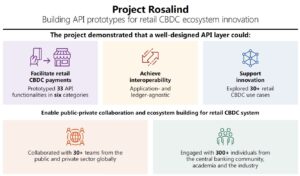BIS and UK Central Bank Study Reveals Retail CBDC’s Potential for Cheaper and Easier Peer-to-Peer Payments
In July 2022, the Bank for International Settlements (BIS) and the Bank of England (BoE) initiated a collaborative experiment to investigate the implementation of application programming interfaces (APIs) in retail central bank digital currency (CBDC) transactions. The purpose was to explore the potential usage and functionality of prototypes in facilitating retail CBDC transactions.
A report from June 16, summarizing the second phase of Project Rosalind, highlighted that a central bank digital currency (CBDC) has the potential to lower costs and enhance efficiency in peer-to-peer payments. Additionally, it could enable businesses to develop innovative financial products aimed at mitigating fraudulent activities. The findings underscored the transformative possibilities of CBDCs in improving payment systems and fostering secure financial transactions.
Also Read: Bank of England may launch CBDC soon
The comprehensive study resulted in the development of 33 API functionalities and an exploration of over 30 use cases for retail central bank digital currencies (CBDCs). This extensive research aimed to assess the potential applications and functionalities of CBDCs in various retail scenarios, showcasing the versatility and breadth of possibilities offered by these digital currencies.

Project Rosalind CBDC API summary. Source: BIS.
The study went beyond examining the functionality of a central bank digital currency (CBDC) on smartphones, retail vendors, and online stores. It also delved into the concept of “programmability,” which involves tailoring digital currency to behave according to predetermined conditions. This exploration of programmability showcased the potential for CBDCs to offer customizable and automated features, adding flexibility and adaptability to digital financial transactions.
CBDC programmability has faced skepticism, with critics expressing concerns that a central bank digital currency (CBDC) could be programmed in a way that works against its users. However, the study ultimately concluded that a carefully designed API layer could facilitate secure interaction between a central bank and the private sector, ensuring the provision of safe and reliable retail CBDC payments. The findings emphasized the importance of thoughtful design and collaboration to harness the potential benefits of CBDCs while addressing potential risks.
Project Rosalind, from the #BISInnovationHub London Centre & @bankofengland, explored how a universal and extensible #API layer could connect central bank and private sector infrastructures and facilitate retail #CBDC payments https://t.co/HL7EmI7RWx pic.twitter.com/kDeo0yhrsR
— Bank for International Settlements (@BIS_org) June 16, 2023
Francesca Road, Head of the BIS London Innovation Hub, highlighted the significant progress made by the Rosalind experiment in advancing central bank innovation in two critical areas. According to Road, the experiment explored the role of an API layer in supporting a retail central bank digital currency (CBDC) system while enabling secure and protected CBDC payments across various use cases. These findings were shared in a press release, underscoring the experiment’s valuable contributions to CBDC research and development.
BoE Deputy Governor Jon Cunliffe indicated that, despite the positive outcomes of Project Rosalind, a definitive decision regarding the launch of a central bank digital currency (CBDC) in the country is still several years in the future. Cunliffe’s statement acknowledges that while the research and experimentation are progressing, additional time is required to assess and determine the feasibility and implications of introducing a CBDC in the UK.
During Politico’s Global Tech Day conference, as reported by Bloomberg on June 16, BoE Deputy Governor Jon Cunliffe stated that the likelihood of a central bank digital currency (CBDC) project moving forward currently stands at “seven out of ten.” This statement suggests a significant possibility of a CBDC initiative being pursued, although it does not guarantee its implementation.
Simultaneously with the release of the Project Rosalind findings, enterprise blockchain company Quant Network revealed its participation as a vendor in the study. The announcement had a substantial impact on Quant’s token (QNT), causing its price to surge over 20%, soaring from $96 to $117 within a span of 12 hours. This surge reflected the market’s positive response to Quant’s involvement in the influential project.
Also Read: Ripple and Stellar Collaborate with Central Banks, BIS Partnership Boosts Offline Payments Solutions
Important: This article is intended solely for informational purposes. It should not be considered or relied upon as legal, tax, investment, financial, or any other form of advice.
Follow Cryptos Headlines on Google News
Join Cryptos Headlines Community











